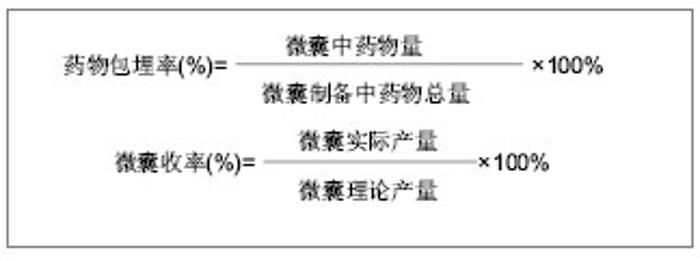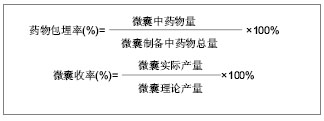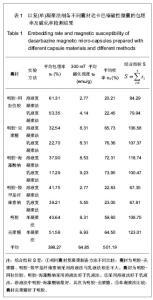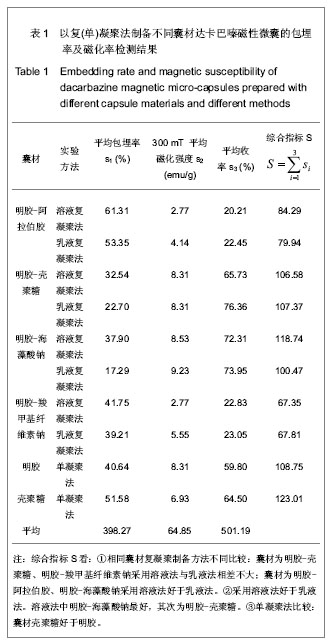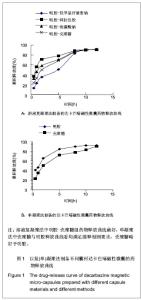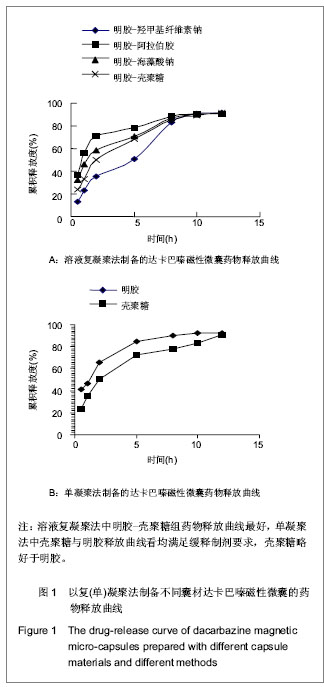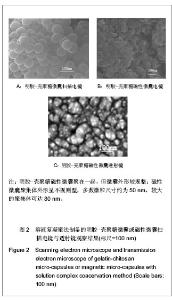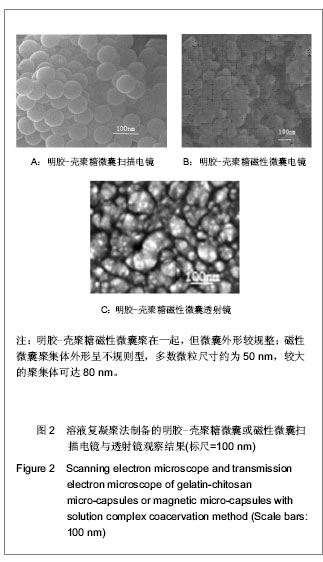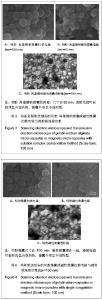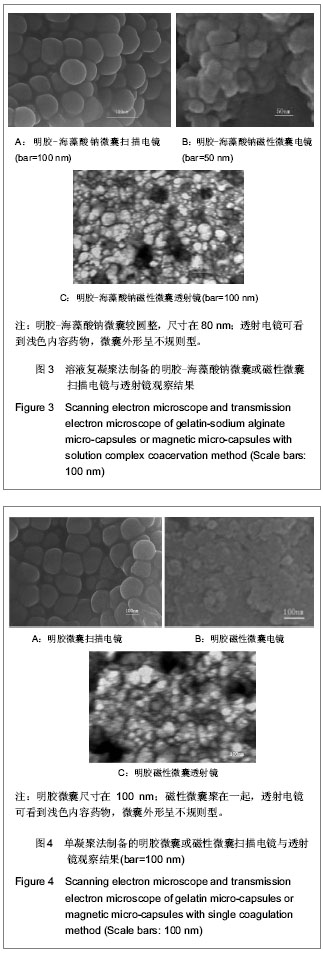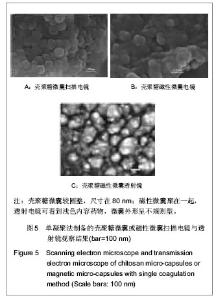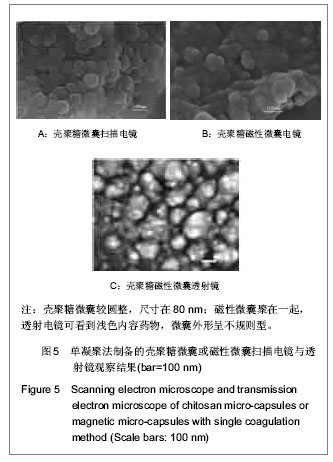| [1] 李可意,林强,冯淑华.双嘧达莫缓释微囊的制备与体外评价[J].中国医院药学杂志,2007,27(12):1678-1681.[2] 谢艳丽,蒋敏,陈鸿雁.复凝聚法制备明胶/阿拉伯胶含油微胶囊工艺过程的研究[J].化学世界,2010,65(1):33-37.[3] 商丹,张朝平,申德君.氨苄西林磁性明胶药物微球的制备及控制释放[J].高校化学工程学报,2009,23(3):537-542. [4] Sunderland CJ,Steiert M,Talmadge JE, et al. Targeted nanoparticles for detecting and treating cancer.Drug Dev Res. 2006;67(1):70-93. [5] 徐星星,朱宏.磁性纳米颗粒及其在生物医学领域中的应用[J].磁性材料及器件,2010,41(5):7-11,33. [6] 赵亮,苏畅.丹参酮Ⅱ_A微囊的制备及其质量考察[J].中成药, 2012,35(7):1242-1246.[7] 王津,李柱来.5-FU壳聚糖-阿拉伯胶缓释微囊的制备工艺研究[J].天然产物研究与开发,2009,21(6):1049-1051.[8] 盘茂东,李嘉诚,林强,等.海藻酸钠在药物控释中的应用[J].中国药业,2008,17(19) :3-5.[9] 李鹤,迟德富,宇佳,等.复凝聚法制备昆虫蜕皮激素微胶囊及其性能[J].化工进展,2010,29(9):1730-1736.[10] 喻樊.复凝聚法制备槲皮素微囊的工艺[J].中国医院药学杂志, 2011,31(15):1308-1310.[11] 李珍辉,李柱来,叶晓.盐酸二甲双胍壳聚糖-海藻酸钠缓释微囊的制备及性能研究[J].解放军医学杂志,2010,47(12):1468-1470.[12] 刘占军,张卫国,于九皋,等.负载紫杉醇壳聚糖纳米粒的制备、表征与释药性能[J].中国组织工程研究与临床康复,2009,13(3): 493-495.[13] 刘洁,谢民强,张涛,等.叶酸分子靶向载顺铂磁性纳米药物制备及表征[J].中国组织工程研究与临床康复,2011,15(6):4631-4637.[14] 邱嘉旋,雷水金,何远桥,等.载顺铂超顺磁γ-Fe2O3纳米粒子的制备与表征[J].中国组织工程研究,2012,16(12):2137-2140.[15] 容建华,段泰炜,温鸿戈,等.热磁双重响应性载药微囊的制备及其性能研究[J].高分子学报,2010,54(4):484-489. [16] 顾杰波,范春雷,胡林峰,等.谷维素-壳聚糖缓释微囊的制备[J].中国组织工程研究与临床康复,2011,15(8):1402-1404.[17] 熊隆荣,文玉华,易成,等.聚乙二醇-4000包覆Fe3O4磁流体的制备及稳定性研究[J].材料导报,2007,21(5):195-198. [18] 郭卫强,焦艳华.高分子磁性微球的研究进展[J].化工技术与开发, 2012,41(7):40-42.[19] 李瑾,郑明学,钱锐,等.影响复凝聚法制备明胶缓释微囊的因素探讨[J].中国畜牧兽医,2009,36(6):207-209.[20] 张海洋,吕怡,倪悦,等.明胶/CMC复合凝聚法制备微胶囊研究[J].食品与机械,2010,26(5):44-47.[21] 姜素芳,周艳琴.丹皮酚微囊的制备及质量评价[J].中国医院药学杂志,2009,29(21):1872-1874.[22] 魏靖明,张志斌,冯华,等.海藻酸钠作为药物载体材料的研究进展[J].化工新型材料,2007,35(8):20-22.[23] 姜炜,李凤生,杨毅,等.磁性壳聚糖复合微球的制备和性能研究[J].材料科学与工程学报,2004,22(5):660-662.[24] 张彦青,张明春,解军波,等.阿司匹林壳聚糖-海藻酸钠微囊处方优化与释药机制研究[J].中国药房,2007,18(4):278-280.[25] 寇灵梅,李冰,郭祀远,等.磁性壳聚糖微球的表征及其磁响应性[J].华南理工大学学报,2006,34(12):92-96.[26] 于炜婷,刘袖洞,李晓霞,等.壳聚糖溶液pH对载细胞海藻酸钠-壳聚糖微胶囊性能的影响[J].高等学校化学学报,2006,23(1): 182-186.[27] 盛文博,朱晓斐,苏佳灿.药物纳米微囊系统材料的选择及制备[J].中国组织工程研究与临床康复,2010,14(25):4709-4712.[28] 余传佩,杨锋,齐飞霞,等.无磁、弱磁材料磁性能的测量方法与装置研究[J].金属功能材料,2008,15(3):34-38.[29] 蒋荣立,陈文龙,张宗祥,等.镝掺杂铁氧体纳米晶的制备、表征和磁性[J].化学学报,2008,66(l1):1322-1326.[30] 冼远芳,范英花,李薇,等.磁天平测定微量磁性微球[J].中国组织工程研究与临床康复,2010,38(14):7116-7118.[31] 周伟华,郭讯枝.司莫司汀聚乙烯吡咯烷酮磁性脂质体的制备[J].中国组织工程研究与临床康复,2009,13(3):496-500.[32] 崔明宇,王艳,孙志伟,等.黄芩苷微囊的制备及体外评价[J].中国实验方剂学杂志,2011,17(11):33-35. |
